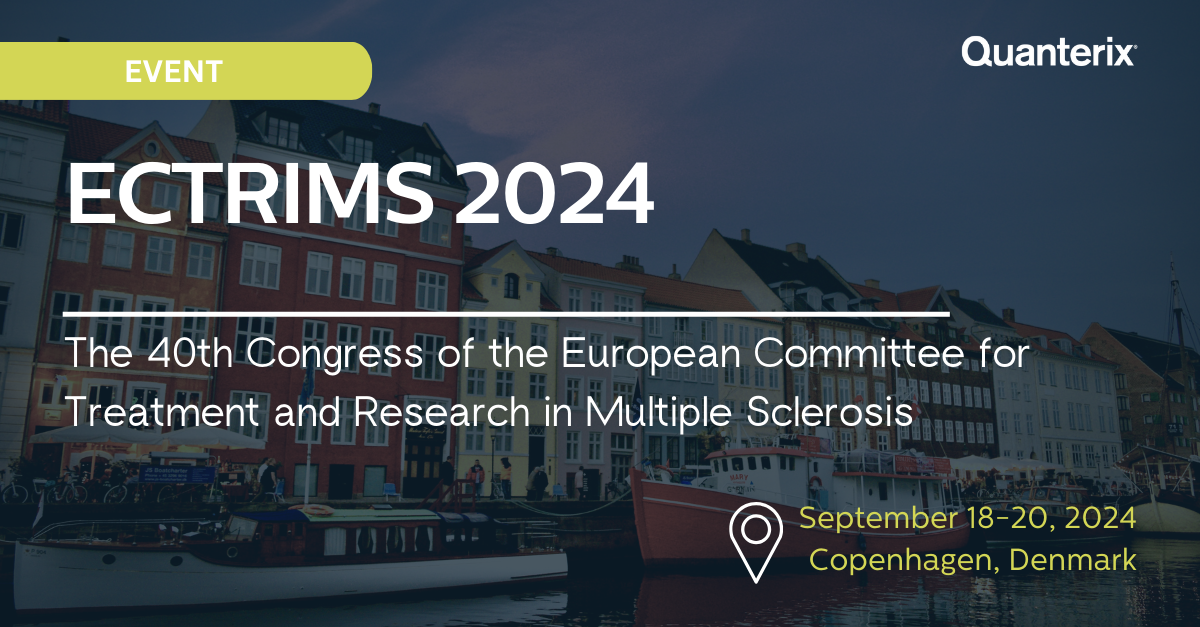
Insights from ECTRIMS 2024: Exploring MS Biomarkers and the Role of Quanterix
At ECTRIMS 2024, leading minds in multiple sclerosis (MS) research gathered to discuss the latest developments in biomarker detection and MS diagnostics. The conference underscored the growing importance of neurofilament light chain (NfL) and glial fibrillary acidic protein (GFAP) as essential biomarkers for MS.
Sessions focused on how these biomarkers are shaping the future of MS treatment and management, with Quanterix’s Simoa® technology playing a pivotal role in advancing detection methods and increasing accessibility for researchers and clinicians alike.
The Role of NfL and GFAP in MS
Discussions at ECTRIMS emphasized the critical role NfL and GFAP play in understanding MS progression and guiding treatment decisions. Multiple sessions centered on the utility of these biomarkers for both early detection and ongoing monitoring of MS. NfL has long been recognized for its ability to track neurodegeneration, while GFAP, which is gaining increasing attention, is proving to be a valuable marker for disease progression, particularly in progressive MS (PMS) and relapse-independent progression (PIRA).
The presentations echoed a shared sentiment: NfL and GFAP are not only essential for understanding disease mechanisms, but they are also critical for applying these insights in clinical practice. For instance, during a session focused on PMS, GFAP was identified as a promising biomarker for monitoring disability worsening and disease progression independent of relapse activity. These discussions reflect an evolving understanding of MS, where biomarkers offer new opportunities for more personalized and precise disease management.
Quanterix’s Simoa® Technology: Leading the Way in Biomarker Detection
Throughout the conference, Quanterix’s Simoa® technology was recognized for its role in advancing biomarker detection, offering the precision and sensitivity necessary for measuring NfL and GFAP levels in blood samples. This is particularly important given that traditional methods, such as cerebrospinal fluid (CSF) sampling, are invasive and costly. The ability to detect these biomarkers through simple blood tests opens the door for broader use in clinical settings and provides an easier, more patient-friendly approach to monitoring disease progression.
Simoa’s® ability to detect NfL and GFAP with such high sensitivity gives researchers and clinicians a clearer understanding of MS, even in its earliest stages. Jens Kuhl’s Z score methodology for NfL and GFAP, often referenced at ECTRIMS, was instrumental in validating the potential of these biomarkers in clinical diagnostics, and Quanterix’s continued work is helping to translate these discoveries into routine practice.
Exploring New Biomarkers and Driving Research Forward
In addition to NfL and GFAP, the conference highlighted ongoing research into new biomarkers, such as CHIT1 and Myelin Oligodendrocyte Glycoprotein (MOG). While these biomarkers are still in the early stages of validation, their potential to complement existing markers like NfL and GFAP is clear. The integration of these novel biomarkers with advanced detection technologies, such as Simoa®, is helping researchers gain a deeper understanding of MS and improve the accuracy of diagnoses and treatments.
Advancements in detection technologies are playing a crucial role in supporting these discoveries. By providing researchers with tools that offer higher sensitivity and precision, Quanterix’s technology is helping to bring new biomarkers from the lab to clinical practice. This collaboration between research and technology is setting the stage for more effective and personalized approaches to MS management.
Looking Ahead: Quanterix’s Commitment to Fueling Scientific Breakthroughs
ECTRIMS 2024 demonstrated the significant progress being made in MS research and diagnostics. For Quanterix, this event reinforced our commitment to fueling breakthroughs from discovery to diagnostics only made possible through Simoa® technology’s ultra-sensitivity and flexibility. Our Simoa® technology continues to play a central role in enabling researchers and clinicians to detect critical MS biomarkers earlier and more accurately, which we believe is essential for improving patient outcomes.
As we look to the future, we remain dedicated to supporting the discovery of new biomarkers and expanding the reach of our technology to new clinical applications. Through our work, we aim to transform how MS is detected, monitored, and managed, contributing to a future where healthcare is more precise, accessible, and personalized.
Learn More About How Quanterix Simplifies Research in Neurology